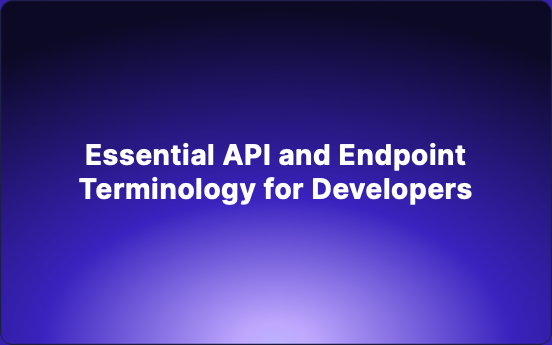Essential API and Endpoint Terminology for Developers
This article delves into fundamental API and endpoint terminology, encompassing HTTP methods, payloads, status codes, authentication, authorization, and rate limiting. Mastery of these concepts is key for developers in crafting and upholding efficient and functional APIs.
APIs(Application Programming Interfaces), the cornerstone of contemporary software development, facilitate smooth communication among diverse applications. Familiarity with the technical jargon surrounding APIs and endpoints is essential for developers to construct, create, and uphold resilient APIs. This blog will delve into prevalent terms in the realm of APIs and endpoints, enhancing understanding and proficiency in API design and maintenance.
API-Related Terminology
In the realm of APIs, understanding key terms is vital for developers. Here are 14 common API-related terms to enhance your knowledge:
- Endpoint:
A specific URL enabling client access to an API for data retrieval or submission. - HTTP Methods:
Request types to endpoints:
- GET: Retrieve server data.
- POST: Send data to the server.
- PUT: Update existing server data.
- DELETE: Remove data from the server.
- Request Payload/Body:
Data sent by the client to the server in requests, often used in POST and PUT operations. - Response Payload/Body:
Data returned by the server to the client post-request. - Status Code:
Server-provided code indicating request outcome (e.g., 200 OK, 404 Not Found, 500 Internal Server Error). - Headers:
Key-value pairs in API requests/responses offering metadata. - Authentication:
Verifying user/client identity through methods like API keys, OAuth, and JWT. - Authorization:
Determining user/client permissions for actions or data access. - Rate Limiting:
Governing client request volume within a timeframe to prevent misuse. - Throttling:
Regulating request processing pace, akin to rate limiting. - Latency:
Time from API request initiation to response receipt. - CORS (Cross-Origin Resource Sharing):
Governing resource requests across domains. - API Gateway:
Front-end server managing API requests, security, rate limits, and directing requests to back-end services. - Webhooks:
Real-time data exchange between systems triggered by specific events via HTTP callbacks.
Endpoint-Related Terminology
Understanding endpoint-related terms is crucial for effective API development. Here are 13 key terms to deepen your knowledge:
- Base URL:
The foundational URL for all API endpoints, typically including the protocol (http/https) and domain. - Path Parameter:
A dynamic segment of the endpoint URL used to specify a particular resource (e.g., /users/{userId}). - Query Parameter:
Key-value pairs appended to the endpoint URL to filter or modify requests (e.g., ?sort=asc&limit=10). - Resource:
An entity managed by an API, usually represented as a URL (e.g., /users, /posts). - CRUD Operations:
Fundamental resource actions:
- Create: Adding a new resource (often via POST).
- Read: Retrieving a resource (typically via GET).
- Update: Modifying an existing resource (usually via PUT or PATCH).
- Delete: Removing a resource (commonly via DELETE).
- Versioning:
Managing API changes by creating distinct versions (e.g., /v1/users, /v2/users). - Pagination:
Breaking down extensive data sets into smaller portions, often utilizing query parameters like page and limit. - Serialization:
Converting objects into easily transmittable formats like JSON or XML. - Deserialization:
Reverting serialized data back into object form. - Mock API:
Simulated API versions for testing and development sans a live server requirement. - Schema:
A data structure blueprint, often defined using formats like JSON Schema for validation. - Middleware:
Software intercepting and processing API requests and responses, commonly employed for tasks like logging, authentication, or request modifications. - Error Handling:
Managing and addressing API errors by returning specific status codes and error messages effectively.
Elevate Your API Development with Echoapi: A Comprehensive Free Tool
Developing and testing APIs plays a pivotal role in contemporary software development, and the availability of suitable tools is paramount. Among the various options, EchoAPI emerges as a top-tier, cost-free solution for API development and testing. It bundles API design, development, testing, and documentation into a unified platform, offering a one-stop shop for all API-related needs.

Utilizing EchoAPI, developers can craft resilient APIs with efficiency, replicate server responses, and guarantee smooth integration with external applications. Boasting a user-friendly interface coupled with robust functionalities, EchoAPI proves to be an invaluable asset for developers seeking to refine their API workflows while keeping costs at zero.
Conclusion
Comprehending key API terms is essential for developers working with APIs. These terms not only improve team communication but also enhance developers' abilities to design, implement, and troubleshoot APIs more effectively. Whether dealing with RESTful APIs, GraphQL, or other API types, a solid understanding of these concepts empowers developers to navigate the complexities of modern software development with confidence.




 EchoAPI for VS Code
EchoAPI for VS Code

 EchoAPI for IntelliJ IDEA
EchoAPI for IntelliJ IDEA

 EchoAPl-Interceptor
EchoAPl-Interceptor

 EchoAPl CLI
EchoAPl CLI
 EchoAPI Client
EchoAPI Client API Design
API Design
 API Debug
API Debug
 API Documentation
API Documentation
 Mock Server
Mock Server








